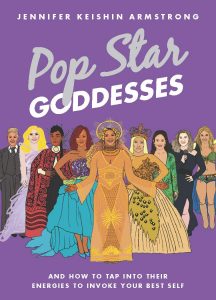Making Nonfiction Your Own By Jennifer Keishin Armstrong
 It’s tempting to say that every book is like your first, but the very good news is that it’s not. Having just published my sixth book, I’ve seen your future—if you’re anywhere between books one and five—and I can assure you that it does get easier. It never gets easy, of course. And every one of my books has found surprising new ways to kick my ass. One of the greatest differences between my first and my sixth is that I know that the challenges are coming. And I know my book and I will survive them.
It’s tempting to say that every book is like your first, but the very good news is that it’s not. Having just published my sixth book, I’ve seen your future—if you’re anywhere between books one and five—and I can assure you that it does get easier. It never gets easy, of course. And every one of my books has found surprising new ways to kick my ass. One of the greatest differences between my first and my sixth is that I know that the challenges are coming. And I know my book and I will survive them.
When I signed on to write my first book, I had no idea what was coming, and this is absolutely the best state of mind for heading into your first book. You would turn and run before you ever committed a word to the page otherwise. I write narrative nonfiction, so my book life cycle is different from a novelist’s; I sell books on proposal, then get to work. In 2009, I got a deal with Grand Central Publishing to write a book about the 1950s Mickey Mouse Club, which would be called Why? Because We Still Like You. I was a working journalist for my entire career—about 13 years at that point—so I had a general sense of what was to come: do a lot of interviews and research, make an outline, write something that resembled a very long article.
But, naturally, it was much harder than that. The research was pretty much as expected. The writing was nothing short of harrowing. I couldn’t just pile facts upon facts in chronological order, chop it up into equal pieces called chapters, and call it a book. I had to build stories—with beginnings, middles, and ends—within a larger story with its own beginning, middle, and end. The facts didn’t always comport with narrative structure. Sometimes I didn’t have enough facts or details.
I slogged and muscled my way through it somehow, but, honestly, just barely. I did have some decent narrative instincts and one lifeline that appeared toward the end of my process, a book by Susan Bell called The Artful Edit. I found this at Barnes & Noble maybe a month before my book was due, followed Bell’s every piece of advice, and got the thing into some working shape. I think the book turned out pretty decently. And, of course, I learned a ton along the way.
I learned how to actually write a book with the next one, Mary and Lou and Rhoda and Ted: And All the Brilliant Minds Who Made The Mary Tyler Moore Show a Classic. A few things were working in my favor this time, besides the simple fact of having gone through the process once already (and having The Artful Edit in my bookcase from Day 1). First, I thought to use a similar great book as a model for my own, Sam Wasson’s Fifth Avenue 5 A.M.: Audrey Hepburn, Breakfast at Tiffany’s, and the Dawn of the Modern Woman. I pored over this book. I analyzed its structure. I made my own outline of it. I read every source note. Then I used this information to make a plan for my own book.
My book still wasn’t quite there on the first draft. I didn’t trust my instincts. I reverted to my old magazine journalism habits that had plagued me during the first book. I was lucky enough this time to be edited by Jon Karp, the publisher at Simon & Schuster who had acquired Mary and Lou. He taught me how to write a book in one magical phone call. I sometimes wish I had recorded this call, because a lot of the specifics escape me now. What I know is that he called my bluff; he literally said, “This reads like a very good, very long article.” He didn’t mean it as a compliment.
What I also know is that I knew how to write a book instead of a long article when I got off the phone with him. And what I remember most is probably what made the difference: He said he could tell which parts of the book’s story excited me. He told me to focus on those and make them come to life. In particular, he told me to start the book with a passage about one of The Mary Tyler Moore Show writers named Treva Silverman and her trajectory from piano prodigy to comedy writer. This was exactly the passage I had wanted to start with, but then had told myself that was wrong. It was too far out of chronological order.
I tried again. He was, of course, right. It’s still one of my favorite chapters that I’ve ever written. It also set the tone for the rest of the book, and I was able to follow that feeling—and those moments of excitement throughout the narrative—to build a book that wasn’t just facts in order. It was my telling of those facts. It was my own expression as much as it was an accurate story.
My sixth book, which recently came out, was a little different: Pop Star Goddesses: And How to Tap Into Their Energies to Invoke Your Best Self, is a collection of 35 essays about modern pop stars and what they represent. It’s not a book-length story with an arc. But it’s certainly a perfect combination of marshalling facts and expressing my own soul.
It’s easy to drown in facts when you write nonfiction. The facts are paramount. But if I had to explain how my “process” has evolved between my first book and my sixth, I would say it’s something like this: Get lots of facts, all the facts, as many as possible. Write them on index cards, put them in order, make a big outline. Write the story using the facts. Now, you’re at the beginning. Now, you can look for yourself in those facts. Where is the juice? Where is the excitement? You’re ready to make it yours. Write to that.
—
Pop Star Goddesses
 A compendium of thirty-five incredible female pop stars whose energies, virtues, and vices make them the ideal role models for our age—powerful women who can teach us all how to discover our own inner goddess.
A compendium of thirty-five incredible female pop stars whose energies, virtues, and vices make them the ideal role models for our age—powerful women who can teach us all how to discover our own inner goddess.
We are living in the age of the music goddess: Beyoncé. Lady Gaga. Taylor Swift. Katy Perry. Britney. Nicki Minaj. Cardi B. Pink. Madonna. Rihanna. Gwen Stefani. Alicia Keys. Kelly Clarkson.
Never before have so many women dominated their industry and pop culture itself with such creativity, passion, and force. Visionary and ferociously talented, these women are reshaping our society and our lives. In this stunningly designed compendium, Jennifer Armstrong offers an intimate, up-close look at thirty-five of pop music’s most revered goddesses, analyzing their performances, songs, videos, interviews, social media, activism, and personal lives to illuminate their significance for both critics and fans.
These divas post astounding album sales, enjoy millions of radio plays, YouTube views, and social media followings, and sell out stadiums. While we are awed and inspired by their success, we worship them for so much more. Beyoncé’s work ethic. Nicki Minaj’s no-bullshit attitude. Taylor Swift’s relatability. Pink’s sense of social justice. Jennifer Lopez’s transformation from “Jenny from the block” to fashion icon. Each of these goddesses speaks to us in her own unique way. Beyoncé is our superhuman alter ego; Britney is our survival instinct.
Armstrong pairs each pop star goddess with a corresponding goddess from ancient cultures, and offers advice on how to invoke the pop star goddess’s energy in your own life, providing journal prompts and a Power Song List that allows you harness the power of a particular pop goddess’s energy when you need it.
Filled with information, advice, insights, playlists, and forty gorgeous color illustrations, Pop Star Goddess will help you tune in and turn on your own divine energy.
https://www.harpercollins.com/9780062943699/pop-star-goddesses/
Category: Contemporary Women Writers, How To and Tips
























